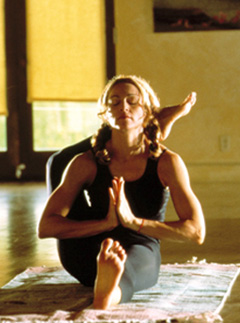 |
| Ashtanga Yoga Poses - What's the Point, Really? |
"Ashtanga yoga poses" is a frequently search phrase on Google. There are two very different ideas about that term ashtanga yoga today though, so the website you land on might not be quite what you're looking for. The Sanskrit word Ashtanga means "eight limbs" (ashta means eight, and anga means limb), referring to the traditional system of yoga comprised of 8 essential, interconnected parts.
But the term ashtanga yoga has also gotten attached to a modern exercise system that focuses heavily on part, the yoga pose. Yoga poses, though, are only the tip of the iceberg in yoga. If you don't go very far beyond them, you simply AREN'T DOING YOGA.
How many limbs do you have?
The first steps in astanga yoga are the yamas and niyamas. If you've read anything about yoga, I'm sure you've heard about these morals and ethics. Yogis seemed so obsessed with them... Come on though, who doesn't know that we should be good people? Step three though... now we're getting into the good stuff... those yoga poses! If Jennifer Aniston keeps looking younger everyday with them, then I definitely want to do yoga too! Yeah, we've all heard about step 4 too... the BORING yoga breathing... Ok, five minutes of that is enough. I know how to breathe...
But what really comes next?
After these first four step, yoga gets very hazy for most people. Even most yoga teachers get pretty new-age flakey when they start to talk about the higher levels of yoga. It seems that the lack of student interest in the higher stages of yoga is rivalled only by the lack of enthusiasm by teachers to educate about them. But guess what... It's in the higher four stages, where yoga actually begins!
What's the point of the first four limbs then?
We all know the saying, "you need to crawl before you can walk." The first four limbs are "yoga crawling" so to speak... preparation for the higher stages. But one of the biggest yoga delusions people have is thinking that, because they can contort their body into all sorts of extreme positions, they are "advanced" in yoga.
The ashtanga yoga poses are indeed great tools for improving and maintaining our physical health. They even help ground us a lot on the mental and emotional levels too. But transforming from someone who is deeply attached to their possessions, emotional dramas and relationships in this world, into someone who is able to detach from all these things and experience the real joy of being part of this miracle of life, requires a journey to the higher yoga mountain peak.
If we don't want to go there, then perhaps our yoga teachers haven't done a good enough job to inspire us... to let us know what we're missing, and why we need to set our sites a little higher. If we don't outgrow our attachment to the Ashtanga yoga poses, then we'll be stuck in that land of preparation forever. The question is, what exactly are we preparing for?

.jpg)



.jpg)
